
The Golden Arches are the symbol of McDonald's, the global fast food restaurant chain. Originally, real arches were part of the restaurant design. They were incorporated into the chain's logo in 1962, which resembled a stylized restaurant, and in the current Golden Arches logo, introduced 1968, resembling an "M" for "McDonald's". They are widely regarded to be one of the most recognizable logos in the world.

Michael Lynn Retzer, Sr. is an American Republican politician from Mississippi who was United States Ambassador to Tanzania from 2005 to 2007.

The Community Theatre is a historic theatre building at 207 West 2nd Avenue in Pine Bluff, Arkansas. It is a two-story brick building, finished in stucco, with Moderne styling. It was built in 1889, and housed first a furniture store, and then a five and dime, before being converted for theatrical use in the 1920s. Its present Moderne styling dates to renovations made in the wake of a 1951 fire.

The oldest McDonald's restaurant is a drive-up hamburger stand at 10207 Lakewood Boulevard at Florence Avenue in Downey, California, United States. It was the third McDonald's restaurant and opened on August 18, 1953. It was also the second restaurant franchised by Richard and Maurice McDonald, before the involvement of Ray Kroc in the company. The restaurant is the oldest one in the chain still in existence and is one of Downey's main tourist attractions. Along with its sign, it was deemed eligible for addition to the National Register of Historic Places in 1984, although it was not added at the time because the owner objected.

Union Station is a former railroad station at East 4th Ave. and State St. in Pine Bluff, Jefferson County, Arkansas. The station was originally at the union of the Cotton Belt and Iron Mountain railroads, and now houses the Pine Bluff/Jefferson County Historical Society museum. It is a single-story brick building, with a hip roof whose long eaves are supported by iron columns and half-truss brackets. The station was built in 1906 by the Iron Mountain Railroad. It had been a stop on the St. Louis Southwestern's Lone Star (Memphis-Dallas), and also on the railway's St. Louis-Dallas trains.
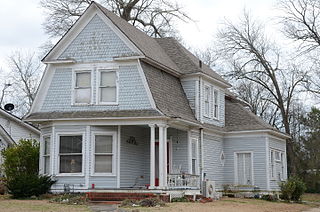
The Gatewood House is a historic house at 235 Pine Bluff Street in Malvern, Arkansas. It is a two-story wood-frame structure, roughly rectangular in plan, with a gambrel roof and weatherboard exterior. The gambrel roof is unusual in that the upper level slightly overhangs the steeper lower parts. The front-facing gable rests above a polygonal bay window on the left and a recessed porch on the right, which is supported by clustered Tuscan columns. Built in 1905, the building represents a well-executed example of a vernacular interpretation of the Shingle style of architecture.
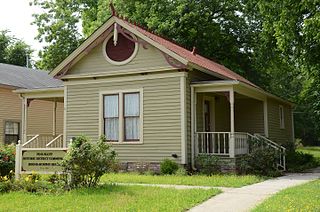
The Boone–Murphy House is a historic house located in Pine Bluff, Arkansas.
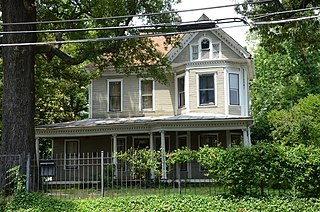
The Gibson-Burnham House is a historic house at 1326 Cherry Street in Pine Bluff, Arkansas. It is a roughly L-shaped two story wood-frame structure, with a hip roof across its front and a gabled rear section. A single-story porch extends across the front, supported by Ionic columns. Its interior has well-preserved original woodwork, including notable a staircase built out of quarter-sawn oak and displayed at the 1904 St. Louis World's Fair. Built in 1904 by a local plantation owner, it is a fine local example of Colonial Revival architecture.

The Hudson House is a historic house at 304 West 15th Street in Pine Bluff, Arkansas, USA. It is a 2-½ story structure, faced with brick on the main floors, and with half-timbered stucco in the front-facing gable. which is further accentuated by large brackets. A single-story hip-roofed porch extends across the front, supported by brick piers. The house was designed by Charles L. Thompson and was built in 1911. It is a high-quality local example of Craftsman architecture.

The R.M. Knox House is a historic house at 1504 West 6th Street in Pine Bluff, Arkansas. It is a two-story wood-frame structure, with a T-shaped floor plan and a cross-gable roof. A mansard-roofed tower rises at the center of the house, and an elaborately decorated two-story porch extends across a portion of the front. The house was built in 1885 for Richard Morris Knox, a veteran of the American Civil War. It is one of the state's finest and most elaborate examples of the Eastlake style.
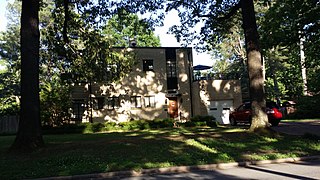
The Jewel Bain House Number 2 is a historic house at 3601 South Cherry Street in Pine Bluff, Arkansas. It is a roughly cubic brick structure, two stories in height, covered by a hip roof. The brick walls are accented with carrara glass. A carport extends from the main block to the south, and a single-story ell extends south. Built in 1937, the house was the second of four houses designed by Jewel Bain for her family. It is rare within the state as an excellent example of a residential application of the Moderne style of architecture.

The R.E. Lee House is a historic house at 1302 West 2nd Street in Pine Bluff, Arkansas. It is a 1+1⁄2-story wood-frame structure, with asymmetrical massing and complex roof line characteristic of the Queen Anne period of architecture. The house is set on a lot with an original period wrought iron fence. A three-story corner tower with bellcast six-side roof projects from one corner, with an elaborately decorated Eastlake-style porch sheltering its entrance. Built in 1893, it is an outstanding local example of the Queen Anne style.
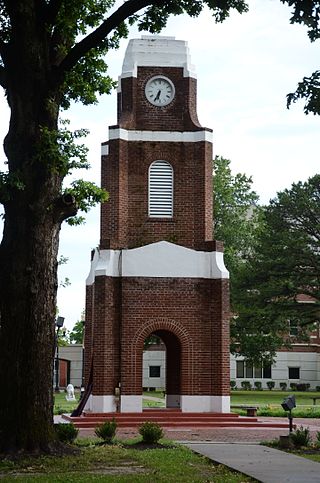
The W.E. O'Bryant Bell Tower occupies a prominent central position on the campus of the University of Arkansas at Pine Bluff in Pine Bluff, Arkansas. It is a three-stage brick structure, with open arches at the base where a fountain once stood. The second stage houses a belfry, and the third a clock. The corners are buttressed, and the levels divided by bands of concrete. The tower was built in 1943–47.
The Dr. John Walter Parker Sr. House is a historic house at 1405 South Alabama Street in Pine Bluff, Arkansas. It is a single-story brick building, with a complex gabled roof line and a porch that curves from the front around to the left side. Built in 1909–10, it is believed to be one of the first brick houses in the community to be built for, and owned by, an African American. John Walker Parker, for whom it was built, was a dentist who opened his practice in Pine Bluff in 1905.

The Pine Bluff Confederate Monument has long been located in front of the Jefferson County courthouse, at Barraque and Main Streets in Pine Bluff, Arkansas. It depicts a standing Confederate Army soldier, holding a rifle whose butt rests on the ground. The statue, built out of Georgia marble by the McNeel Marble Company, stands on a stone base 15 feet (4.6 m) in height and 10 by 10 feet at the base. It was placed in 1910 by the local chapter of the United Daughters of the Confederacy.

The Prigmore House is a historic house at 1104 West Fifth Avenue in Pine Bluff, Arkansas. It is a two-story wood-frame structure, with a gable roof, weatherboard siding, and a high brick foundation. A single-story gabled ell extends to the rear. A single-story porch extends across the front facade, supported by grouped columns. The house was built about 1873 by George Prigmore, a veteran of the American Civil War, and is a rare surviving property in Pine Bluff from that period.

The Trulock-Cook House is a historic house at 703 West 2nd Avenue in Pine Bluff, Arkansas. It is a 1+1⁄2-story wood-frame structure, built about 1903 in an unusual combination of Shingle and Colonial Revival styles. It has a two-stage gambrel roof, which slopes down in one section to form the roof of a single-story porch that wraps around the porch on the southwest corner. The porch also wraps around a semicircular bay that rises above the main entrance, and is supported by Tuscan columns. The house is one of Pine Bluff's few surviving Shingle style buildings.

The Trulock-Gould-Mullis House is a historic house at 704 West Barraque Street in Pine Bluff, Arkansas. It is a 1+1⁄2-story wood-frame structure, a gabled roof with a large cross gable, and clapboard siding. The cross gable is set over the main entrance, which is sheltered by a porch extending across the front facade. The gable has set in it three narrow round-arch windows, in a Palladian style where the outer windows are slightly smaller. The cornice line is decorated with bargeboard. The house was built in 1876 for Marshall Trulock, and is locally distinctive for its unusual Gothic features.

The Yauch-Ragar House is a historic house at 625 State Street in Pine Bluff, Arkansas. It is a single-story brick structure, with a hip roof. A gable projects from the front, with a large segmented-arch window at the center, and a smaller similar window in the gable. To the projecting section's left, a porch is supported by Tuscan columns. Built in 1907, the house is a rare example of brick construction from that period. It was built by William Yauch, who with his brother owned a local brickworks.
The George Howard Jr. Federal Building and United States Courthouse is a federal government building at 100 East 8th Street in Pine Bluff, Arkansas. It is a roughly square building, three stories in height, with a steel frame and curtain glass exterior. Single-story brick sections project to the east and west of its main block, and the south side houses the building's service entrances. It was completed in 1967, and is a prominent local example of Modern architecture. It is also a significant local example of an urban renewal project; it was built in a swampy area previously occupied by "substandard housing". It was named in honor of Pine Bluff native George Howard Jr. in 2008, and continues to house Pine Bluff's main post office as well as federal courts.






















